Um die Last auf mehrere Nextcloud Instanzen zu verteilen schalten wir einen Loadbalancer (HAProxy) vor die Nextcloud Webserver. Zudem verschlüsseln wir die Kommunikation mit SSL sowohl nach extern, als auch nach intern.
Drei Konfigurationsbeispiele aus dem Enterprise-Umfeld finden sie weiter unten in diesem Artikel.
Download: https://codeberg.org/criegerde/HAProxy/src/branch/main/Layer4or6
In dieser Anleitung gehen wir von dieser exemplarischen Umgebung aus:
- haproxy – 192.168.2.205
- nc1 – 192.168.2.206
- nc2 – 192.168.2.207
Zuerst passen wir die hosts-Datei auf allen Servern an:
sudo -s
nano /etc/hosts
# Server: haproxy 127.0.0.1 localhost 127.0.1.1 haproxy ... 192.168.2.205 haproxy 192.168.2.206 nc1 192.168.2.207 nc2
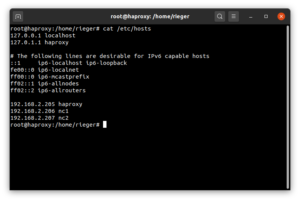
# Server: nc1 127.0.0.1 localhost 127.0.1.1 nc1 ... 192.168.2.205 haproxy 192.168.2.206 nc1 192.168.2.207 nc2
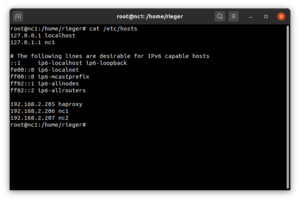
# Server: nc2 127.0.0.1 localhost 127.0.1.1 nc2 ... 192.168.2.205 haproxy 192.168.2.206 nc1 192.168.2.207 nc2
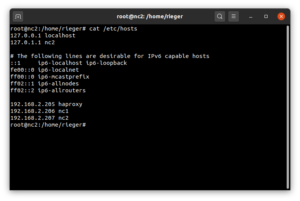
Nun aktualisieren wir den haproxy-Server und installieren den HAProxy-Loadbalancer:
apt update && apt upgrade -y
apt-get install --no-install-recommends software-properties-common add-apt-repository ppa:vbernat/haproxy-2.6 apt install socat haproxy=2.6.\*
Um sich den Status des Loabalancers „live“ ansehen zu können nutzen wir das Tool HATOP:
wget http://archive.ubuntu.com/ubuntu/pool/universe/h/hatop/hatop_0.8.0-1.1_all.deb
dpkg -i hatop*.deb
Ruft man nach Fertigstellung des HAProxys das HATop-Tool wie folgt auf,
hatop -s /run/haproxy/admin.sock
so erhält man eine „Live“-Sicht, auf den Loadbalancer.
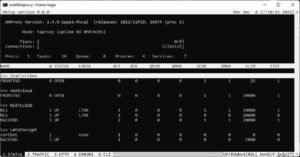
Am Beispiel von self signed SSL-Zertifikaten verschlüsseln wir sowohl die Kommunikation zum Loadbalancer, als auch die Kommunikation zwischen dem Loadbalancer und den Nextcloud-Instanzen. Um das realisieren zu können installieren wir
apt install ssl-cert
und generieren uns neue self-signed SSL_Zertifikate
make-ssl-cert generate-default-snakeoil -y
Um diese Zertifikate im HAProxy nutzen zu können, fügen wir das Zertifikat und den PrivatKey in eine Datei zusammen:
cat /etc/ssl/private/ssl-cert-snakeoil.key /etc/ssl/certs/ssl-cert-snakeoil.pem > /etc/haproxy/server.pem
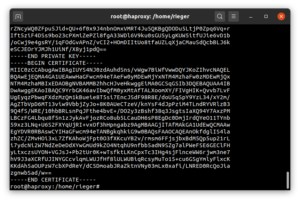
Zudem generieren wir uns ein dhparam.pem-File, um auch den Schlüsselaustausch selbst abzusichern:
openssl dhparam -dsaparam -out /etc/haproxy/dhparam.pem 2048
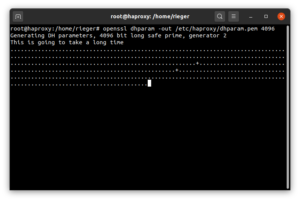
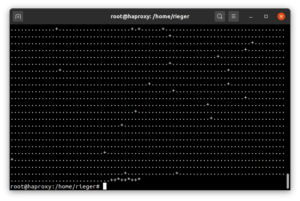
Die Vorbereitungen sind nun abgeschlossen, so dass wir den HAProxy (Layer6 / http-Mode) konfigurieren können. Beginnen wir mit einer Sicherungskopie der Standardkonfiguration.
touch /var/log/haproxy.log chown syslog:adm /var/log/haproxy.log cd /etc/haproxy cp haproxy.cfg haproxy.cfg.bak
Öffnen Sie dann die Konfigurationsdatei und ersetzen den kompletten Inhalt mit dem nachfolgenden Block:
global
log /dev/log local0
log /dev/log local1 notice
chroot /var/lib/haproxy
stats socket /run/haproxy/admin.sock mode 660 level admin expose-fd listeners
stats timeout 30s
user haproxy
group haproxy
daemon
# Default SSL material locations
ca-base /etc/ssl/certs
crt-base /etc/ssl/private
ssl-default-bind-ciphers ECDHE-ECDSA-AES128-GCM-SHA256:ECDHE-RSA-AES128-GCM-SHA256:ECDHE-ECDSA-AES256-GCM-SHA384:ECDHE-RSA-AES256-GCM-SHA384:ECDHE-ECDSA-CHACHA20-POLY1305:ECDHE-RSA-CHACHA20-POLY1305:DHE-RSA-AES128-GCM-SHA256:DHE-RSA-AES256-GCM-SHA384
ssl-default-bind-ciphersuites TLS_AES_128_GCM_SHA256:TLS_AES_256_GCM_SHA384:TLS_CHACHA20_POLY1305_SHA256
ssl-default-bind-options prefer-client-ciphers no-sslv3 no-tlsv10 no-tlsv11 no-tls-tickets
ssl-default-server-ciphers ECDHE-ECDSA-AES128-GCM-SHA256:ECDHE-RSA-AES128-GCM-SHA256:ECDHE-ECDSA-AES256-GCM-SHA384:ECDHE-RSA-AES256-GCM-SHA384:ECDHE-ECDSA-CHACHA20-POLY1305:ECDHE-RSA-CHACHA20-POLY1305:DHE-RSA-AES128-GCM-SHA256:DHE-RSA-AES256-GCM-SHA384
ssl-default-server-ciphersuites TLS_AES_128_GCM_SHA256:TLS_AES_256_GCM_SHA384:TLS_CHACHA20_POLY1305_SHA256
ssl-default-server-options no-sslv3 no-tlsv10 no-tlsv11 no-tls-tickets
ssl-dh-param-file /etc/ssl/certs/dhparam.pem
defaults
log global
mode http
option httplog
option dontlognull
timeout connect 5000
timeout client 50000
timeout server 50000
errorfile 400 /etc/haproxy/errors/400.http
errorfile 403 /etc/haproxy/errors/403.http
errorfile 408 /etc/haproxy/errors/408.http
errorfile 500 /etc/haproxy/errors/500.http
errorfile 502 /etc/haproxy/errors/502.http
errorfile 503 /etc/haproxy/errors/503.http
errorfile 504 /etc/haproxy/errors/504.http
listen stats
bind :8443 ssl crt /etc/haproxy/server.pem alpn h2,http/1.1 ssl-min-ver TLSv1.2
maxconn 5
mode http
stats enable
stats show-legends
stats hide-version
stats refresh 30s
stats show-node
stats uri /
frontend NEXTCLOUD
mode http
bind :80
bind :443 ssl crt /etc/haproxy/server.pem alpn h2,http/1.1 ssl-min-ver TLSv1.2
maxconn 20000
acl url_discovery path /.well-known/caldav /.well-known/carddav
http-request redirect location /remote.php/dav/ code 301 if url_discovery
redirect scheme https code 301 if !{ ssl_fc }
http-response set-header Strict-Transport-Security max-age=63072000
acl is_certbot path_beg /.well-known/acme-challenge/
use_backend LetsEncrypt if is_certbot
default_backend NEXTCLOUD
backend NEXTCLOUD
balance leastconn
cookie SERVERID insert indirect nocache
option httpchk GET /login
http-check expect rstatus [2-3][0-9][0-9]
server server1 192.168.2.206:443 check maxconn 10000 ssl verify none ca-file /etc/haproxy/server.pem cookie nc1
server server2 192.168.2.207:443 check maxconn 10000 ssl verify none ca-file /etc/haproxy/server.pem cookie nc2
backend LetsEncrypt
mode http
server certbot 127.0.0.1:9080
Konfigurationsbeispiele aus dem Enterprise-Umfeld:
- Layer 6 / http-mode mit Healthcheck und SSL-Terminierung am HAProxy
- Layer 4 / tcp-mode mit http-Healthcheck
- Layer 4 / tcp-mode mit SNI (verschiedene Anwendungen, bspw. Nextcloud und BigBlueButton)
Beispiel 1: Layer 6 / http-mode mit http-Healthcheck:
global
log /dev/log local0
log /dev/log local1 notice
chroot /var/lib/haproxy
stats socket /run/haproxy/admin.sock mode 660 level admin expose-fd listeners
stats timeout 30s
user haproxy
group haproxy
daemon
ca-base /etc/ssl/certs
crt-base /etc/ssl/private
ssl-default-bind-ciphers ECDHE-ECDSA-AES128-GCM-SHA256:ECDHE-RSA-AES128-GCM-SHA256:ECDHE-ECDSA-AES256-GCM-SHA384:ECDHE-RSA-AES256-GCM-SHA384:ECDHE-ECDSA-CHACHA20-POLY1305:ECDHE-RSA-CHACHA20-POLY1305:DHE-RSA-AES128-GCM-SHA256:DHE-RSA-AES256-GCM-SHA384
ssl-default-bind-ciphersuites TLS_AES_128_GCM_SHA256:TLS_AES_256_GCM_SHA384:TLS_CHACHA20_POLY1305_SHA256
ssl-default-bind-options ssl-min-ver TLSv1.2 no-tls-tickets
tune.ssl.cachesize 1000000
ssl-dh-param-file /etc/haproxy/dhparam.pem
defaults
log global
mode http
option httplog
option dontlognull
timeout connect 5000
timeout client 50000
timeout server 50000
errorfile 400 /etc/haproxy/errors/400.http
errorfile 403 /etc/haproxy/errors/403.http
errorfile 408 /etc/haproxy/errors/408.http
errorfile 500 /etc/haproxy/errors/500.http
errorfile 502 /etc/haproxy/errors/502.http
errorfile 503 /etc/haproxy/errors/503.http
errorfile 504 /etc/haproxy/errors/504.http
frontend Statistiken
bind *:8443 ssl crt /etc/haproxy/server.pem alpn h2,http/1.1 ssl-min-ver TLSv1.2
mode http
option httplog
maxconn 5
stats enable
stats show-legends
stats hide-version
stats refresh 60s
stats show-node
stats uri /
frontend NEXTCLOUD
mode http
bind :80
bind :443 ssl crt /etc/haproxy/server.pem alpn h2,http/1.1 ssl-min-ver TLSv1.2
acl url_discovery path /.well-known/caldav /.well-known/carddav
http-request redirect location /remote.php/dav/ code 301 if url_discovery
redirect scheme https code 301 if !{ ssl_fc }
http-response set-header Strict-Transport-Security max-age=63072000
acl is_certbot path_beg /.well-known/acme-challenge/
use_backend LetsEncrypt if is_certbot
default_backend NEXTCLOUD
backend NEXTCLOUD
mode http
fullconn 20000
balance leastconn
stick-table type ip size 128m expire 2h
stick on src
option forwardfor
option httpchk GET /login
http-check expect rstatus [2-3][0-9][0-9]
server NC1 192.168.2.206:443 weight 1 inter 5s downinter 20s rise 4 fall 2 check ssl verify none ca-file /etc/haproxy/server.pem on-marked-down shutdown-sessions maxconn 10000
server NC2 192.168.2.207:443 weight 1 inter 5s downinter 20s rise 4 fall 2 check ssl verify none ca-file /etc/haproxy/server.pem on-marked-down shutdown-sessions maxconn 10000
backend LetsEncrypt
mode http
server certbot 127.0.0.1:9080
# (c) Carsten Rieger IT-Services, v. 220102
Beispiel 2: Layer 4 / tcp-mode mit http-Healthcheck:
global
log /dev/log local0
log /dev/log local1 notice
chroot /var/lib/haproxy
stats socket /run/haproxy/admin.sock mode 660 level admin expose-fd listeners
stats timeout 30s
user haproxy
group haproxy
daemon
ca-base /etc/ssl/certs
crt-base /etc/ssl/private
ssl-default-bind-ciphers ECDHE-ECDSA-AES128-GCM-SHA256:ECDHE-RSA-AES128-GCM-SHA256:ECDHE-ECDSA-AES256-GCM-SHA384:ECDHE-RSA-AES256-GCM-SHA384:ECDHE-ECDSA-CHACHA20-POLY1305:ECDHE-RSA-CHACHA20-POLY1305:DHE-RSA-AES128-GCM-SHA256:DHE-RSA-AES256-GCM-SHA384
ssl-default-bind-ciphersuites TLS_AES_128_GCM_SHA256:TLS_AES_256_GCM_SHA384:TLS_CHACHA20_POLY1305_SHA256
ssl-default-bind-options ssl-min-ver TLSv1.2 no-tls-tickets
tune.ssl.cachesize 1000000
ssl-dh-param-file /etc/haproxy/dhparam.pem
defaults
log global
mode tcp
option tcplog
option dontlognull
timeout connect 5000
timeout client 50000
timeout server 50000
errorfile 400 /etc/haproxy/errors/400.http
errorfile 403 /etc/haproxy/errors/403.http
errorfile 408 /etc/haproxy/errors/408.http
errorfile 500 /etc/haproxy/errors/500.http
errorfile 502 /etc/haproxy/errors/502.http
errorfile 503 /etc/haproxy/errors/503.http
errorfile 504 /etc/haproxy/errors/504.http
frontend Statistiken
bind *:8443 ssl crt /etc/haproxy/server.pem alpn h2,http/1.1 ssl-min-ver TLSv1.2
mode http
option httplog
maxconn 5
stats enable
stats show-legends
stats hide-version
stats refresh 60s
stats show-node
stats uri /
frontend NEXTCLOUD
bind *:443
maxconn 20000
mode tcp
option tcplog
tcp-request inspect-delay 5s
tcp-request content accept if { req_ssl_hello_type 1 }
default_backend NEXTCLOUD
backend NEXTCLOUD
mode tcp
fullconn 20000
balance leastconn
stick-table type ip size 100m expire 2h
stick on src
option httpchk GET /login
http-check expect rstatus [2-3][0-9][0-9]
server server1 192.168.2.206:443 weight 1 inter 5s downinter 20s rise 4 fall 2 check check-ssl verify none on-marked-down shutdown-sessions maxconn 10000
server server2 192.168.2.207:443 weight 1 inter 5s downinter 20s rise 4 fall 2 check check-ssl verify none on-marked-down shutdown-sessions maxconn 10000
# (c) Carsten Rieger IT-Services, v. 220102
Beispiel 3: Layer 4 / tcp-mode SSL passthrough für Nextcloud und BigBlueButton:
global
log /dev/log local0
log /dev/log local1 notice
chroot /var/lib/haproxy
stats socket /run/haproxy/admin.sock mode 660 level admin
stats timeout 30s
user haproxy
group haproxy
daemon
# Default SSL material locations
ca-base /etc/ssl/certs
crt-base /etc/ssl/private
# See: https://ssl-config.mozilla.org/#server=haproxy&server-version=2.0.3&config=intermediate
ssl-default-bind-ciphers ECDHE-ECDSA-AES128-GCM-SHA256:ECDHE-RSA-AES128-GCM-SHA256:ECDHE-ECDSA-AES256-GCM-SHA384:ECDHE-RSA-AES256-GCM-SHA384:ECDHE-ECDSA-CHACHA20-POLY1305:ECDHE-RSA-CHACHA20-POLY1305:DHE-RSA-AES128-GCM-SHA256:DHE-RSA-AES256-GCM-SHA384
ssl-default-bind-ciphersuites TLS_AES_128_GCM_SHA256:TLS_AES_256_GCM_SHA384:TLS_CHACHA20_POLY1305_SHA256
ssl-default-bind-options ssl-min-ver TLSv1.2 no-tls-tickets
defaults
log global
mode tcp
option tcplog
timeout connect 5000
timeout client 50000
timeout server 50000
errorfile 400 /etc/haproxy/errors/400.http
errorfile 403 /etc/haproxy/errors/403.http
errorfile 408 /etc/haproxy/errors/408.http
errorfile 500 /etc/haproxy/errors/500.http
errorfile 502 /etc/haproxy/errors/502.http
errorfile 503 /etc/haproxy/errors/503.http
errorfile 504 /etc/haproxy/errors/504.http
frontend proxy
bind *:443
mode tcp
option tcplog
maxconn 10000
tcp-request inspect-delay 5s
tcp-request content accept if { req_ssl_hello_type 1 }
acl Nextcloud req_ssl_sni -i nextcloud.domain.de
acl BigBlueButton req_ssl_sni -i bbb.domain.de.de
use_backend Nextcloud if Nextcloud
use_backend BigBlueButton if BigBlueButton
backend Nextcloud
mode tcp
fullconn 5000
balance source
stick-table type binary len 32 size 1m expire 600m
acl clienthello req_ssl_hello_type 1
acl serverhello rep_ssl_hello_type 2
tcp-request inspect-delay 5s
tcp-request content accept if clienthello
tcp-response content accept if serverhello
stick on payload_lv(43,1) if clienthello
stick store-response payload_lv(43,1) if serverhello
option ssl-hello-chk
server Nextcloud 192.168.2.206:443 check maxconn 5000
backend BigBlueButton
mode tcp
fullconn 5000
balance source
stick-table type binary len 32 size 1m expire 600m
acl clienthello req_ssl_hello_type 1
acl serverhello rep_ssl_hello_type 2
tcp-request inspect-delay 5s
tcp-request content accept if clienthello
tcp-response content accept if serverhello
stick on payload_lv(43,1) if clienthello
stick store-response payload_lv(43,1) if serverhello
option ssl-hello-chk
server BigBlueButton 192.168.2.234:443 check maxconn 5000
Nach dem Speichern der Konfigurationsdatei, gefolgt von einem Neustart des HAProxys
service haproxy restart
können Sie die Status-Seite des Loadbalancers bereits aufrufen (https://192.168.2.205:8443):
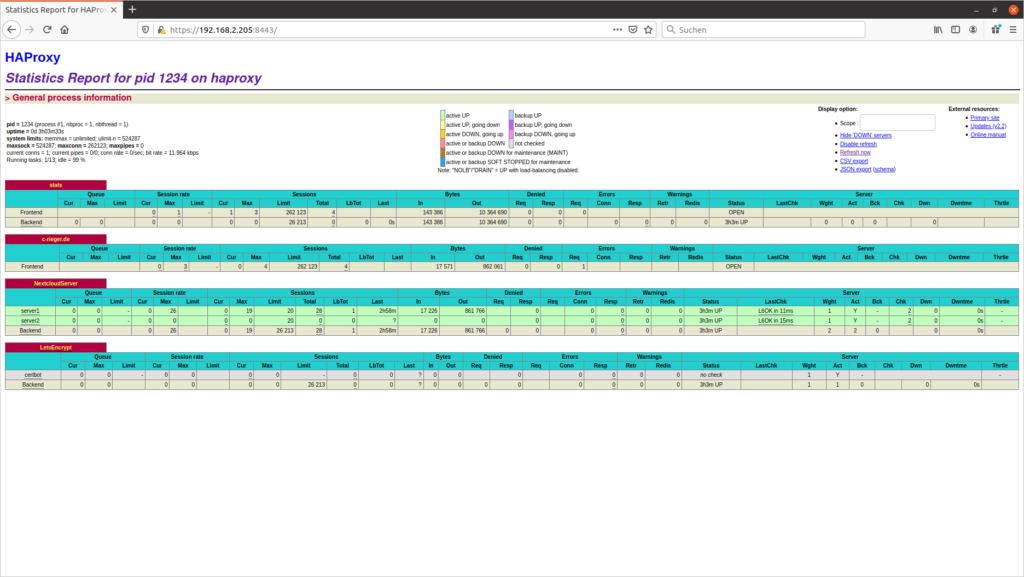
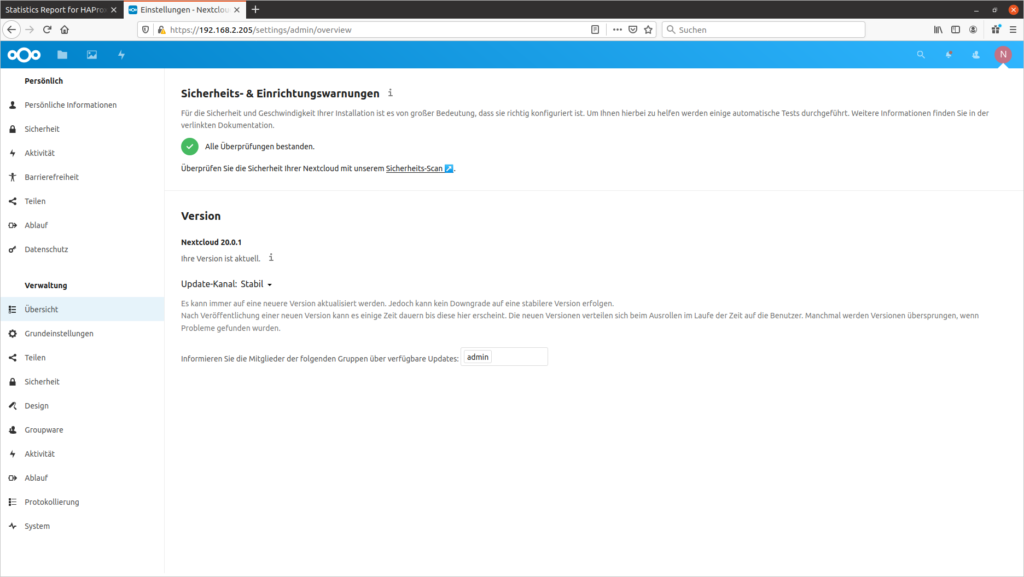
Vorausgesetzt, Sie haben die Nextcloud-Instanzen (Backends) bereits aufgesetzt (Lesen Sie mehr in diesem Artikel), so können Sie diese „lastverteilt“/“gebalanced“ über https://192.168.2.205 erreichen.
Überprüfen Sie sowohl in der Nextcloud, als auch in der Browserkonsole das Balancingverhalten. Dazu sehen Sie sich zum Einen die System-Einstellungen der Nextcloud an und vollziehen dort visuell nach, auf welchem Node (Knoten/Server) Sie sich befinden. Zum Anderen sehen Sie sich das Pendant, also den vom HAProxy gesetzten Cookie, in der Browserkonsole an. Beide spiegeln im Beispiel den Server nc1 wider.
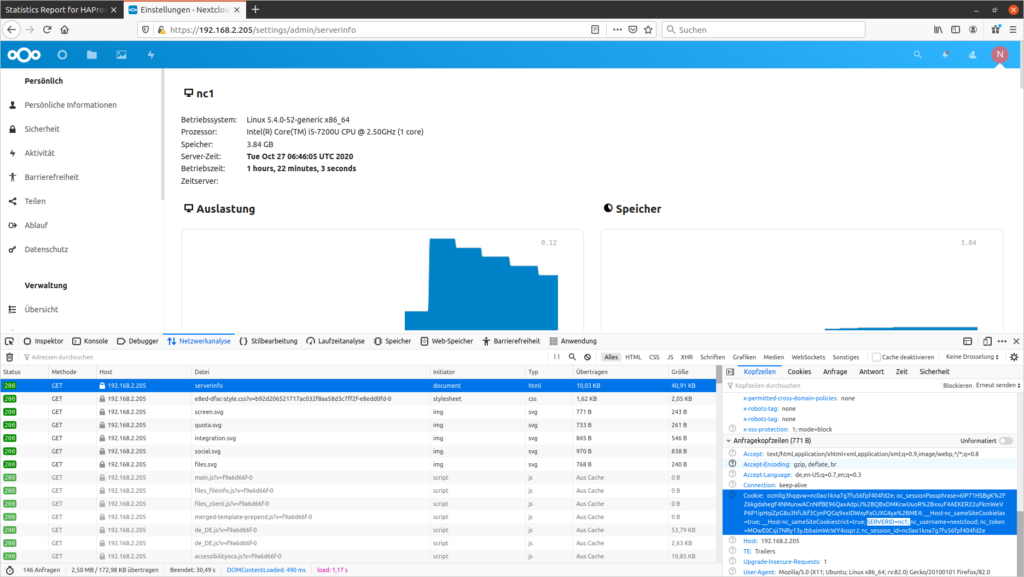
Möchten Sie Let’s Encrypt Zertifikate nutzen, so installieren Sie die Let’s Encrypt Software certbot (URL):
apt install snapd snap install core && snap refresh core apt remove certbot snap install --classic certbot ln -s /snap/bin/certbot /usr/bin/certbot
Mittels des Kommandozeilentools certbot requestieren wir die SSL Zertifikate
certbot certonly --standalone --preferred-challenges http --http-01-address 127.0.0.1 --http-01-port 9080 -d ihre.domain.de --email ihre@domain.de --agree-tos --non-interactive
und nutzen dann ein Skript um alle Zertifikate zu konsolidieren:
nano /etc/haproxy/le-certificates.sh
#!/bin/bash for CERTIFICATE in `find /etc/letsencrypt/live/* -type d`; do CERTIFICATE=`basename $CERTIFICATE` cat /etc/letsencrypt/live/$CERTIFICATE/fullchain.pem /etc/letsencrypt/live/$CERTIFICATE/privkey.pem > /etc/haproxy/server.pem done exit 0
Nun machen wir das Skript noch ausführbar
chmod +x /etc/haproxy/le-certificates.sh
und führen es aus.
/etc/haproxy/le-certificates.sh
Nach einem Neustart des HAProxy-Services
services haproxy restart
werden die neuen Let’s Encypt SSL-Zertifikate schon verwendet.
Um die Zertifikate automatisch zu erneuern benötigen wir ein weiteres Skript:
nano /etc/haproxy/le-renewal.sh
#!/bin/bash certbot renew --standalone --preferred-challenges http --http-01-address 127.0.0.1 --http-01-port 9080 --post-hook "/etc/haproxy/le-certificates.sh && systemctl reload haproxy.service" --quiet exit 0
Auch dieses Skript muss wieder ausführbar gemacht werden
chmod +x /etc/haproxy/le-renewal.sh
Nun legen wir noch den wöchentlichen Cronjob an
crontab -e
@weekly /etc/haproxy/le-renewal.sh > /dev/null
wodurch die Zertifikate wöchentlich auf Aktualisierungen geprüft werden und bei einer Aktualisierung auch der haproxy-Service neu gestartet wird.
Die Installation und Einrichtung des HAProxy-Loadbalancers wurde somit erfolgreich abgeschlossen. Über Ihre Unterstützung (diese wird ordnungsgemäß versteuert!) würden sich meine Frau, meine Zwillinge und ich sehr freuen. Vielen Dank!




